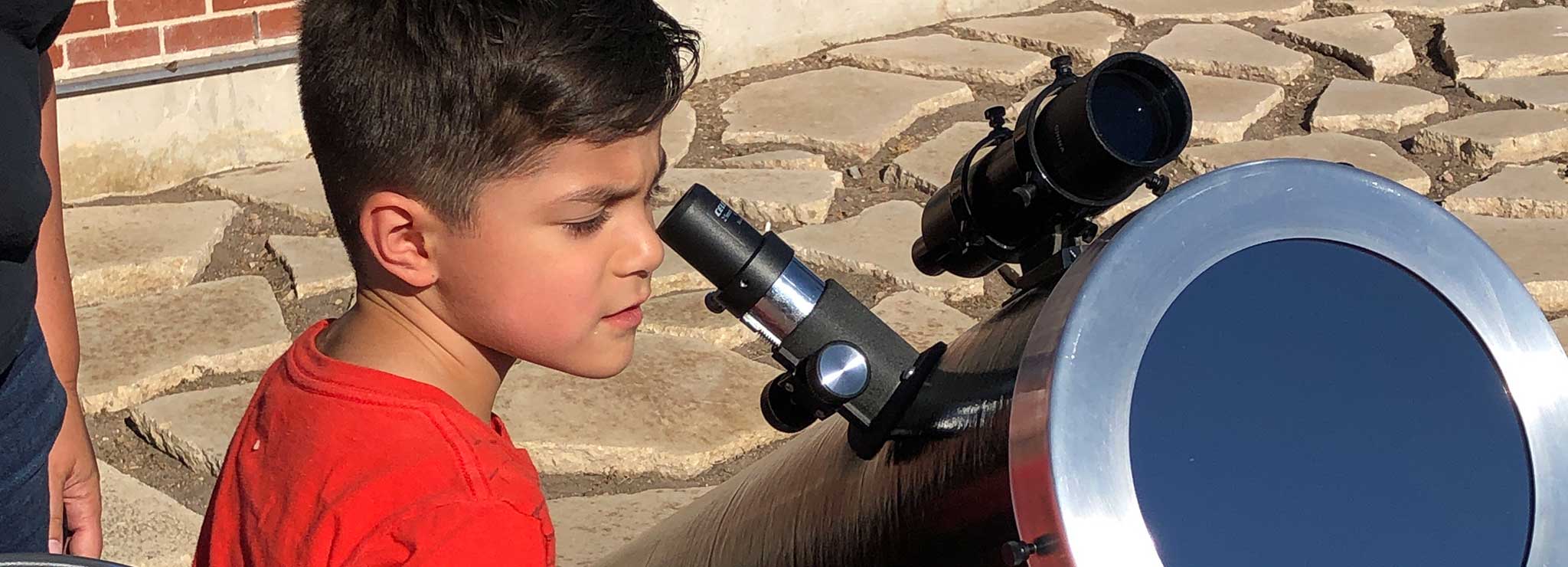Blogs | 4.8.2024
Engaging Students in STEM

All space missions are important, but Challenger STS-51L was special—Christa McAuliffe was to be the first Teacher In Space. In this mission, Christa and the crew would inspire students and teachers across the globe by sharing a lesson from space. This entire crew was extraordinary. They were leaders, innovators, and passionate explorers who were committed to making the world a better place.
Committed to keeping their education mission alive, the crews’ families came together in 1986 to create Challenger Center. While a lot has changed since this organization was established 38 years ago, our successful model remains the same: Use the awe and wonder of space to excite students while giving them a chance to see themselves in STEM roles.
In the last two parts of this blog post series, Kris Brown, NASA’s Deputy Associate Administrator for STEM Education, and I discussed the importance of diversity and student identity in STEM, as well as challenges and solutions to improving our country’s STEM workforce pipeline. This month, we talk about how we, as educators, can inspire and engage our future STEM leaders…
Inspiring Today’s Students
 Kris, what do we need to be doing for the K-12 students of today so they can be the innovators and explorers of tomorrow that we so desperately need, in our country and around the globe?
Kris, what do we need to be doing for the K-12 students of today so they can be the innovators and explorers of tomorrow that we so desperately need, in our country and around the globe?
 We should continue to focus on creating more learning opportunities that are relevant and compelling, and address how we can best engage students in learning by doing, including activities that enable them to explore solutions to real-world needs and problems. Lance, I know you are fully committed to this through your work at Challenger Center, where your partners across the country are enabling students to see themselves in STEM through compelling and fun hands-on learning programs.
We should continue to focus on creating more learning opportunities that are relevant and compelling, and address how we can best engage students in learning by doing, including activities that enable them to explore solutions to real-world needs and problems. Lance, I know you are fully committed to this through your work at Challenger Center, where your partners across the country are enabling students to see themselves in STEM through compelling and fun hands-on learning programs.
Over the past couple of years, we’ve enhanced NASA K-12 engagement efforts to include those real-world experiences, and capitalized on exciting NASA missions like the Artemis program’s return to the Moon, James Webb Space Telescope, and our missions in space and Earth science.
We also need to focus on reaching students where they are; particularly, reaching students who don’t yet see themselves in STEM. I’m a choral singer, so I like to use this metaphor: We need to continue to support those students who are already ‘in the choir’ . . . yet focus more on those who are not. I’m thrilled to see students who are progressing along our continuum of learning opportunities, but we need to focus as much or more of our energy on those who are not ‘in the choir’.
One way we do that is by trying to reach students through their interests that are not related to STEM. For example, we’ve worked with partner organizations to develop and deploy essay contests to reach students interested in writing while engaging them in relevant STEM topics. We also collaborate with arts organizations to reach students through art and music, to engage them in STEM topics and activities, and build bridges to connect them to our work in space.
 Learning by doing is such a pillar of successful STEM education. You and I agree on this, and the challenges and solutions for K-12 STEM engagement. This is a big job. How can we accomplish this?
Learning by doing is such a pillar of successful STEM education. You and I agree on this, and the challenges and solutions for K-12 STEM engagement. This is a big job. How can we accomplish this?
 Indeed, Lance. Those of us working across the education ecosystem are cognizant of the multi-faceted challenges we’re trying to tackle in engaging K-12 students in STEM. For those of us involved in student engagement efforts, one way we can make headway in what you characterized as that “big job” is by working in partnership with one another. We can make a larger impact working together! At NASA STEM Engagement, we’ve built a strategic partnerships function, where we form partnerships with external organizations to expand our footprint and impact. Through our partnership activities last year alone, we reached over ten million students.
Indeed, Lance. Those of us working across the education ecosystem are cognizant of the multi-faceted challenges we’re trying to tackle in engaging K-12 students in STEM. For those of us involved in student engagement efforts, one way we can make headway in what you characterized as that “big job” is by working in partnership with one another. We can make a larger impact working together! At NASA STEM Engagement, we’ve built a strategic partnerships function, where we form partnerships with external organizations to expand our footprint and impact. Through our partnership activities last year alone, we reached over ten million students.
There is great value in engaging in this work with others. Through these efforts, as well as through our grant and cooperative agreements with organizations and academia, and Space Grant consortia across all 50 states, DC, and Puerto Rico, we can magnify our investments and impact through networks and partnerships.
NASA Programs for STEM Engagement
 NASA STEM Engagement has some really great informative and educational programs for educators. Can you share a little more about these programs and how educators can get involved?
NASA STEM Engagement has some really great informative and educational programs for educators. Can you share a little more about these programs and how educators can get involved?
 Sure, we’re always looking to have more educators join us! We have a new platform and community of practice for K-12 teachers and informal educators: NASA CONNECTS – Connecting Our NASA Network of Educators for Collaborating Together in STEM. You can register and be part of this community, with access to NASA resources and people. We also have a weekly e-newsletter that goes out to thousands of educators across the country with information on resources and upcoming events and activities.
Sure, we’re always looking to have more educators join us! We have a new platform and community of practice for K-12 teachers and informal educators: NASA CONNECTS – Connecting Our NASA Network of Educators for Collaborating Together in STEM. You can register and be part of this community, with access to NASA resources and people. We also have a weekly e-newsletter that goes out to thousands of educators across the country with information on resources and upcoming events and activities.
In terms of some K-12 activities, last fall, we opened registration for NASA Sparking Participation and Real-world eXperiences in STEM (SPARX), providing educators with hands-on, standards-aligned activities, professional development training, and resources to help engage students.
In our TechRise Student Challenge, student teams in grades 6-12 design and build experiments ahead of suborbital flight tests.
Recently, we brought members of our NASA STEM team together and explored how we could develop a way to help move the needle in educating our nation’s children and increasing their understanding of Earth and climate science, and the importance of protecting our home planet. As a result, we created Earthrise—a new initiative we launched in collaboration with other federal agencies that will provide a monthly issue of educational resources and learning opportunities for educators. I’m really excited about the possibilities. Earthrise is elevating Earth and Climate Science in classrooms across the country. I encourage all educators out there to register and join us!
Keeping Your Students Motivated
 For our educators who are at the forefront of inspiring students, what would you advise them to say to young students, particularly those underserved learners, who are interested in STEM, but might feel discouraged?
For our educators who are at the forefront of inspiring students, what would you advise them to say to young students, particularly those underserved learners, who are interested in STEM, but might feel discouraged?
 Lance, as I know you’ll agree, it’s a gift to be able to interact with students and talk about the work we do and share opportunities that are out there waiting for them. When I get the opportunity to speak to students, I focus on what I now call my “six Cs,”—a fun way for them to focus on what I believe to be the key ingredients in a recipe that will help them along the way:
Lance, as I know you’ll agree, it’s a gift to be able to interact with students and talk about the work we do and share opportunities that are out there waiting for them. When I get the opportunity to speak to students, I focus on what I now call my “six Cs,”—a fun way for them to focus on what I believe to be the key ingredients in a recipe that will help them along the way:
- Curiosity: I encourage young students to put on their ‘exploration hats’ and be curious about the world around them. And that goes for older students and all of us who work in STEM too! We need to look for new ways to learn and try something new. Being open to learning and not being in fear of failing is important for all of us to learn as early as possible.
- Creativity: Creativity is at the heart of STEM. We create and design new products, new and better ways of doing things, and enable new knowledge and understanding of our world and how things work. Thinking creatively and ‘out of the box’ is another key ingredient for success.
- Competence: To be successful in STEM, you must first learn to be competent at what you do. Building on a foundation of competence—having the skills and understanding you need to work with others on your team and make meaningful contributions—is an essential component of a career in STEM and leads to confidence.
- Confidence: Being confident in yourself and your abilities can be incredibly powerful in dealing with disappointments and setbacks.
- Commitment: In all walks of life, having a strong sense of commitment is a key ingredient for meaningful work and contributions. In STEM, determination, tenacity, and patience are essential because STEM pursuits are inherently challenging. There are times when we’ve all been discouraged or frustrated, but overcoming challenges and learning from failures are all part of the process.
- Collaboration: STEM is a team sport! We’re lucky to work with lots of talented, interesting, and passionate people in the work we do, and it takes a real commitment to being a great team to take on the bold work we do and accomplish mighty things!
Inspire Your Students to Dream Big
We, as U.S. citizens, are fortunate to have the likes of Kris Brown working for NASA to address our country’s STEM education challenges. She has a clear view of the value that STEM Education has on our society, and the challenges and solutions it will take to carry us forward. It’s always a pleasure to collaborate with her and I cannot thank Kris enough for participating in our interview series.
Let me close by reemphasizing the future we can plot for ourselves. STEM education equips students with the tools they need to tackle the challenges of an ever-evolving world, navigate the complexities of our time, and become the architects of their futures. Together, we have the power to inspire the next generation of scientists, engineers, and innovators. We have the privilege of shaping the minds that will cure diseases, explore distant planets, build sustainable cities, and solve the grand challenges of our time. We can ignite the potential of every student, inspire greatness, and shape a future that is better than we could have ever dreamt.
